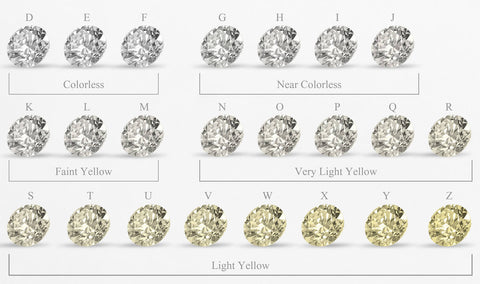When you're in search of the perfect engagement ring, the colour of the diamond is an exquisite detail that can truly set your ring apart. While the sparkle of a diamond may first catch your eye, understanding the subtleties of diamond colour can truly make your ring stand out. Just like love, diamonds come in many shades and tints that can affect the overall appeal and value of your token of commitment. Here's a detailed guide to help you understand and choose the right diamond colour for your engagement ring.
Understanding the Diamond Colour Scale
The Gemological Institute of America (GIA), a renowned authority in gemmology, has established a colour-grading scale for diamonds, which categorises them from D (colourless) to Z (light yellow or brown). Each letter grade represents a range of colour and is measured by comparing a stone under controlled lighting and precise viewing conditions to master-stones of established colour value.

The Colourless Diamonds (D, E, F)
Diamonds graded D, E, or F are considered colourless. Radiating pure brilliance, diamonds in the 'Colourless' range are coveted for their lack of hue. They are the rarest and, consequently, the most expensive. These icy-white diamonds possess a peerless sparkle and shine since they have the least amount of colour to absorb light.
These gems, when cut to perfection, can exhibit unparalleled sparkle since they allow the maximum amount of light to enter and reflect back. Choosing a colorless diamond for your engagement ring ensures a timeless, classic beauty that stands out for its purity and quality.
Near Colourless Diamonds (G, H, I, J)
Offering superb value, diamonds classified as 'Near Colourless' range (G, H, I, J) display negligible colour when looked at with the naked eye, especially when mounted in jewellery. They can provide a more budget-friendly option without sacrificing any visible brilliance. For practical romantics, this range is an exquisite compromise that bonds affordability with the traditional appeal of a nearly colourless gem.
The Faint Colour Range (K, L, M)
Moving down the colour scale, K, L, M diamonds exhibit a faint yellow hues and warmer tones, which can add a unique character to an engagement ring.. These diamonds can still be beautiful, but they do possess noticeable colour that can affect the brilliance and fire of the stone. The warmth of these diamonds can exude a vintage charm many couples find endearing. Set against rose gold or yellow gold, faint colour diamonds emit a harmonious glow that celebrates a more antique aesthetic.
Very Light and Light Yellow Diamonds (N to Z)
Diamonds graded N to Z show an increasingly yellow or brown tint. These stones are less commonly used for engagement rings but can suit those who prefer a warm-coloured diamond at a lower price point.
Coloured Diamonds
Venturing beyond the traditional colour scale are the fancy coloured diamonds, such as pinks, blues, and canaries, which have captured the imagination with their vivid hues and distinctive presences. For couples seeking to reflect a colourful zest for life or a desire to stand out, fancy coloured diamonds can express individuality and boldness with every facet.
The Role of Fluorescence
Some diamonds exhibit a trait known as fluorescence – a soft glow (usually blue) which is invisible under most lighting conditions. Strong fluorescence can make some lower colour (I-J, K-M) stones appear more colourless or white in UV light, such as sunlight.
Factors Influencing the Appearance of Diamond Colour
A diamond's setting can heavily influence its color appearance. For instance, a rose or yellow gold setting can mask some yellowish colour in a diamond, while platinum or white gold can make the diamond appear more colourless.
Choosing the Best Diamond Colour for Your Ring
When selecting the ideal diamond colour for an engagement ring, consider the metal of the band. White gold and platinum, both with their silvery tones, pair well with higher grade colourless diamonds, accentuating their icy sheen. Yellow and rose gold, with their warmer hues, complement diamonds across the colour spectrum, by either contrasting with high-grade colourless stones or enhancing the golden undertones of lower-colour diamonds.
Another factor to consider is the size of the diamond. Larger diamonds can display colour more prominently, which may influence your decision if you're seeking a stone with substantial carat weight. Here, closer attention to colour grades might prove beneficial to maintain the desired appearance.
Finally, reflect upon personal preference and budget. What truly matters is how the diamond speaks to you as a couple. Some may find allure in the pure radiance of a colourless gem, while others may treasure the personalized touch of a diamond with a hint of colour. Balance your desires with your financial comfort, and remember that the best choice is one that holds meaning and beauty for you and your beloved.
This is when talking to a diamond expert like Monroe Yorke diamonds is beneficial. They will talk you through different diamond options and find you the most perfect diamond for your lifelong commitment.
Selecting Your Diamond
Selecting the colour of your diamond is an entirely personal choice and depends on preference and budget. For those in pursuit of the ultimate colourless stone, aim for a D to F diamond. If a balance between quality and value is desired, G to J range diamonds are a solid choice. And for individuals who appreciate a hint of warmth or are looking for a more affordable option, K to M diamonds can still provide beauty and character.
When shopping for your gem, always consider the metal type of your band, potential fluorescence in the diamond, and of course, how it complements your significant other's style. Each diamond tells a story—choose the shade that best reflects your own.
Whether pursuing traditional elegance or a more distinctive ring, understanding diamond colour is crucial in making an informed engagement ring decision. With this guide, couples can confidently choose a diamond that not only sparkles with brilliance but also mirrors the deep hues of their enduring love.
Remember, the highest priority should be what appeals to you and your partner the most. A diamond’s colour and its cut proportions can influence its sparkle, but the right choice is one that captures your heart.


